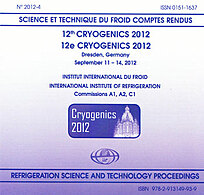
Document IIF
Le système à basse température AEGIS.
The AEGIS low temperature system.
Numéro : pap. n. 073
Auteurs : EISEL T., BREMER J., BURGHART G., et al.
Résumé
The antimatter experiment AEGIS is being constructed at CERN. Its scientific goal is to measure the gravitational interaction between antimatter and ordinary matter. Therefore neutral antihydrogen is subjected to the earth’s gravitational field. In order to perform precise measurements, the antihydrogen needs to be produced at very low temperatures. This is achieved by cooling the combining antiprotons to temperatures of about 100 mK. The antiprotons are trapped and cooled in a Penning trap. The required electrical fields are generated by a series of electrodes, which are charged independently with peak voltages of up to 1 kV. The electrodes are formed by thin gold layers sputtered onto polished sapphire. Sapphire provides reliable electrical insulation and very high thermal conductivity. The bottom of the sapphire is gold sputtered too and is pressed against the mixing chamber of a dilution refrigerator. An indium foil sandwiched between the sapphire and the mixing chamber is used to reduce the thermal boundary resistance.
Documents disponibles
Format PDF
Pages : 102-105
Disponible
Prix public
20 €
Prix membre*
Gratuit
* meilleur tarif applicable selon le type d'adhésion (voir le détail des avantages des adhésions individuelles et collectives)
Détails
- Titre original : The AEGIS low temperature system.
- Identifiant de la fiche : 30005803
- Langues : Anglais
- Source : Cryogenics 2012. Proceedings of the 12th IIR International Conference: Dresden, Germany, September 11-14, 2012.
- Date d'édition : 11/09/2012
Liens
Voir d'autres communications du même compte rendu (78)
Voir le compte rendu de la conférence
Indexation
- Thèmes : Cryogénie : applications de forte puissance
- Mots-clés : Conductivité thermique; Saphir; Cryotempérature; Dilution; Cryorefroidisseur; Cryogénie
-
High-power Stirling-type pulse tube cryocooler ...
- Auteurs : SUN J., DIETRICH M., THUMMES G.
- Date : 11/09/2012
- Langues : Anglais
- Source : Cryogenics 2012. Proceedings of the 12th IIR International Conference: Dresden, Germany, September 11-14, 2012.
- Formats : PDF
Voir la fiche
-
The MITICA facility: a possible optimization of...
- Auteurs : FELLIN F., PASSARDI G., VALENTE M., et al.
- Date : 11/09/2012
- Langues : Anglais
- Source : Cryogenics 2012. Proceedings of the 12th IIR International Conference: Dresden, Germany, September 11-14, 2012.
- Formats : PDF
Voir la fiche
-
Design proposal for MITICA cryogenic plant.
- Auteurs : VALENTE M., FELLIN F., HAAS H., et al.
- Date : 11/09/2012
- Langues : Anglais
- Source : Cryogenics 2012. Proceedings of the 12th IIR International Conference: Dresden, Germany, September 11-14, 2012.
- Formats : PDF
Voir la fiche
-
Cryogenics for the European Spallation Source.
- Auteurs : WANG X. L., KOETTIG T., GALLIMORE S., et al.
- Date : 11/09/2012
- Langues : Anglais
- Source : Cryogenics 2012. Proceedings of the 12th IIR International Conference: Dresden, Germany, September 11-14, 2012.
- Formats : PDF
Voir la fiche
-
Performance analysis of EAST cryogenic control ...
- Auteurs : ZHOU Z. W., ZHANG Q. Y., ZHUANG M., et al.
- Date : 07/04/2014
- Langues : Anglais
- Source : Cryogenics 2014. Proceedings of the 13th IIR International Conference: Prague, Czech Republic, April 7-11, 2014.
- Formats : PDF
Voir la fiche
